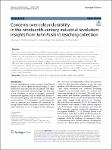Item Infomation
Full metadata record
| DC Field | Value | Language |
|---|---|---|
| dc.contributor.author | Ghigo, Tea | - |
| dc.contributor.author | Occhipinti, Michele | - |
| dc.contributor.author | Beeby, Andrew | - |
| dc.date.accessioned | 2023-08-25T08:42:56Z | - |
| dc.date.available | 2023-08-25T08:42:56Z | - |
| dc.date.issued | 2023 | - |
| dc.identifier.uri | https://link.springer.com/article/10.1186/s40494-023-01010-6 | - |
| dc.identifier.uri | https://dlib.phenikaa-uni.edu.vn/handle/PNK/8962 | - |
| dc.description | CC-BY | vi |
| dc.description.abstract | The numerous new pigments that gradually became available to artists during the nineteenth-century Colour Revolution were received with contrasting attitudes. The initial enthusiasm for new chromatic possibilities was soon nuanced by concerns about the stability and performance of industrial materials. This study focuses on the work of John Ruskin, the famous art critic of Victorian England, whose artistic production was as impressive as his penmanship. Archival research into nineteenth-century literature is combined with material analyses with macro-XRF, XRD and FORS on a group of watercolours by Ruskin preserved at the Ashmolean Museum to determine his attitude towards pigment stability. | vi |
| dc.language.iso | en | vi |
| dc.publisher | Springer | vi |
| dc.subject | macro-XRF | vi |
| dc.subject | XRD | vi |
| dc.title | Concerns over colour durability in the nineteenth-century industrial revolution: insights from John Ruskin’s teaching collection | vi |
| dc.type | Book | vi |
| Appears in Collections | ||
| OER - Khoa học Vật liệu, Ứng dụng | ||
Files in This Item:

